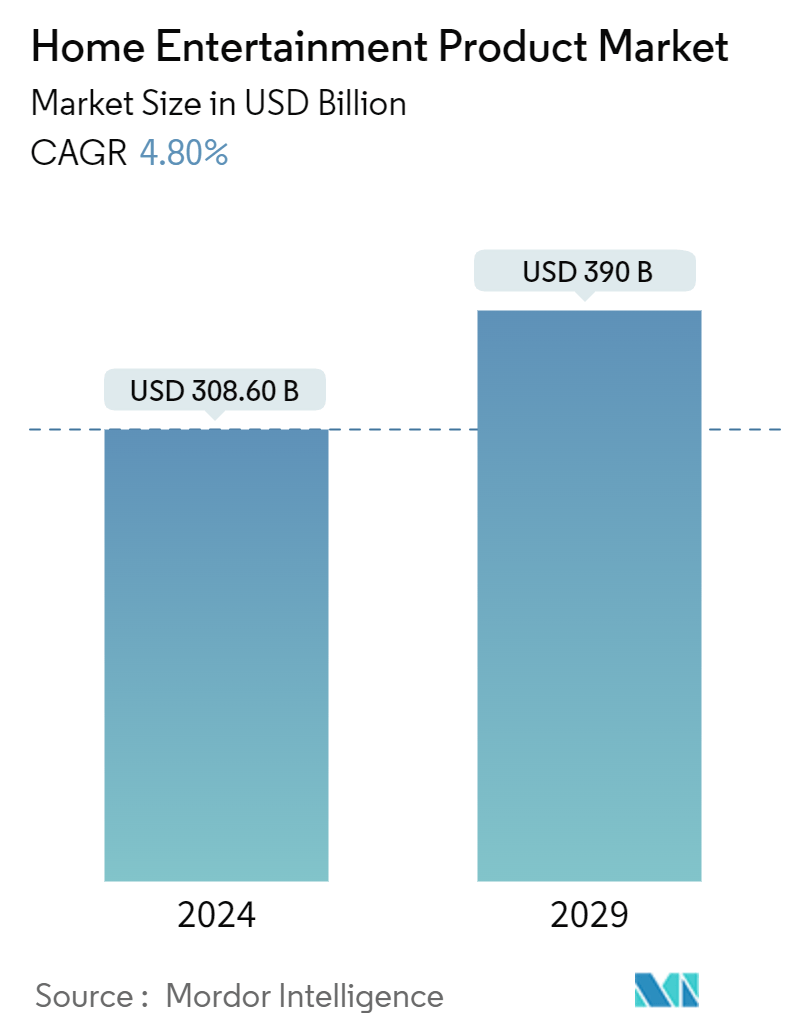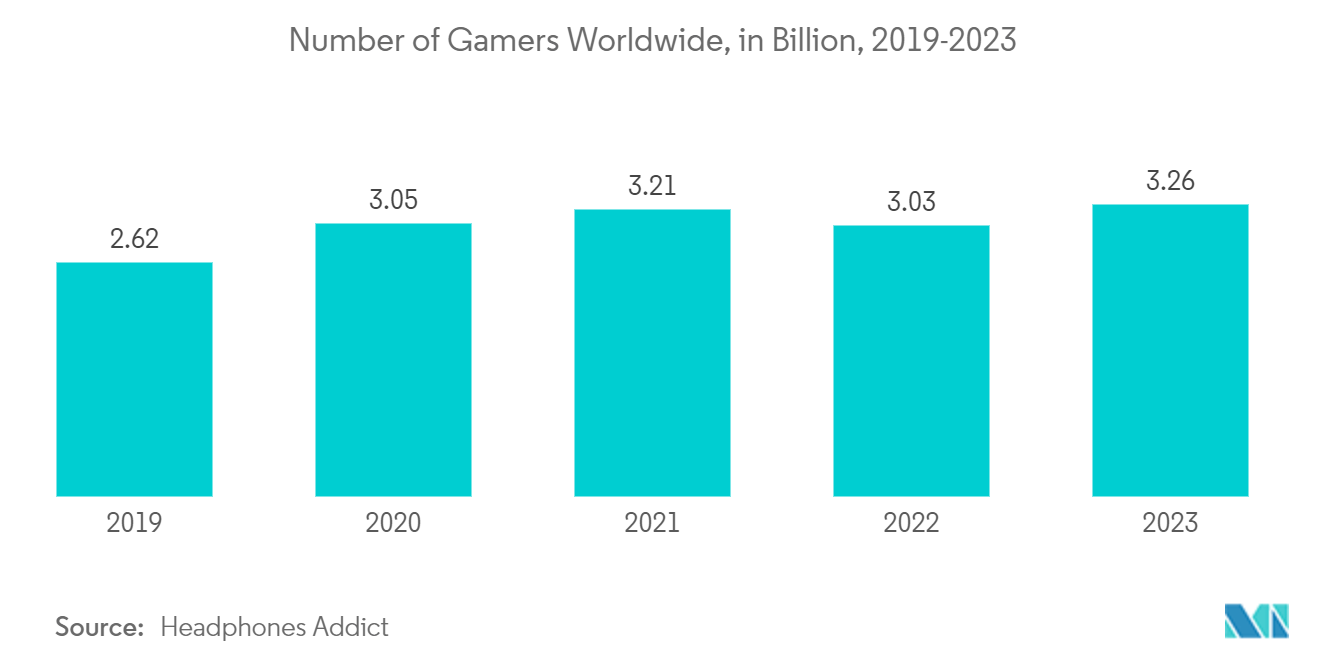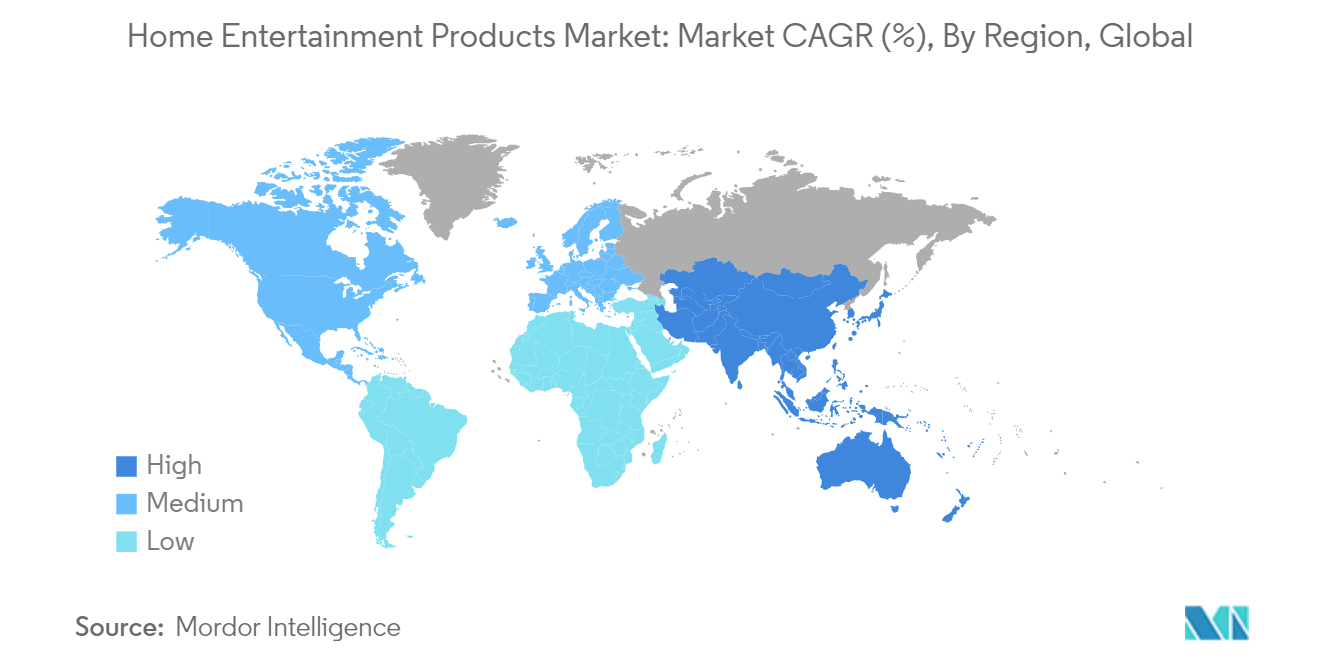Home Entertainment Product Market Size

| Study Period | 2019 - 2029 |
| Market Size (2024) | USD 308.60 Billion |
| Market Size (2029) | USD 390 Billion |
| CAGR (2024 - 2029) | 4.80 % |
| Fastest Growing Market | Asia Pacific |
| Largest Market | North America |
Major Players
*Disclaimer: Major Players sorted in no particular order |
Home Entertainment Product Market Analysis
The Home Entertainment Product Market size is estimated at USD 308.60 billion in 2024, and is expected to reach USD 390 billion by 2029, growing at a CAGR of 4.80% during the forecast period (2024-2029).
Home entertainment devices, including audio boxes, radios, headphones, DVD players, televisions, and gaming consoles, are becoming increasingly popular among consumers. This popularity surge is due to rising disposable incomes, rapid urbanization, evolving lifestyles, and a growing middle class.
• In emerging nations like India, China, Brazil, South Korea, and Japan, disposable incomes have seen significant growth. This uptick has fueled a demand for luxury items, notably home entertainment devices. As a result, there's been a notable shift towards smart and voice-activated devices, especially with the advent of fast broadband. Today's consumers seek higher-quality products, greater convenience, and enriched experiences. Recognizing this trend, home entertainment device manufacturers emphasize aesthetic designs, ensuring their products seamlessly blend into modern home ambiances. This focus on design and functionality is poised to propel market growth in the foreseeable future.
• The pandemic has acted as a promoter, propelling these home entertainment trends to the forefront. With extended hours at home, individuals are keen on enhancing their leisure time, often leading to quicker investments in entertainment products than in prior years. Moreover, as the pandemic nudged consumers towards technology and durable products, it simultaneously bolstered their confidence in tech. This shift is reshaping the dynamics of human-machine interactions.
• Another driving force behind the rising demand for home entertainment products is the surge in online media and streaming services. These platforms cater to consumers' desires for convenience and on-demand content, prompting investments in immersive, high-quality audio-visual experiences.
• Moreover, gaming has emerged as the dominant force in entertainment, outpacing both movies and music in terms of revenue. Its unparalleled ability to immerse users in dynamic virtual realms has eclipsed traditional entertainment forms. Beyond mere play, gaming has transformed into a social phenomenon, allowing players to create, explore, and forge connections with individuals worldwide, bridging cultural divides.
• Yet, the market faces hurdles. Privacy concerns and connectivity issues pose challenges to growth. In addition, the potential health repercussions of prolonged entertainment device use further complicate the market's trajectory.
Home Entertainment Product Market Trends
Gaming Consoles Gaining Popularity
- With a staggering 3.26 billion players globally, gaming has emerged as a cultural melting pot, transcending language barriers and fostering meaningful connections. This rich tapestry of diversity has piqued the interest of advertisers, positioning gaming as a prime arena for brands eager to engage with a varied and attentive audience. The gaming market's expansive reach and inclusive nature make it an attractive platform for advertisers looking to connect with a broad spectrum of consumers.
- According to Gamezop, games, unlike movies or TV shows, boast endless replayability. Players are continually drawn back, enticed by the promise of new discoveries with each session. The thrill of mastering skills and unlocking new levels provides entertainment and a profound sense of accomplishment. This unique engagement and enthusiastic word-of-mouth endorsements distinctly set gaming apart from other entertainment mediums. The dynamic and interactive nature of gaming ensures that players remain engaged over extended periods, creating a loyal and dedicated user base.
- Furthermore, the allure of gaming isn't confined to the industry alone. Companies outside the gaming realm, such as Tata Play, Snap, and Royal Challengers Bangalore, have begun to harness gaming's potential as a powerful engagement tool. By integrating gaming sections into their platforms, these non-gaming entities are strategically capitalizing on the booming demand for gaming in the home entertainment sector. This strategic move enhances user engagement and opens up new revenue streams, demonstrating the far-reaching impact of gaming beyond its traditional boundaries.

North America Expected to Have Significant Share in the Global Market
- With the extensive rollout of 5G across the United States and advancements in Wi-Fi technology, notably Wi-Fi 6, smart home devices are now connecting through faster and more robust networks. This evolution translates to enhanced access to cloud-based processing and data resources. Furthermore, 5G is transforming the delivery of IoT services, including smart home technologies, enabling devices to operate wirelessly and with minimal power consumption.
- Bank of America reports that consumer spending on services remains robust. In 2023, a notable uptick in "out-of-home" entertainment underscored this trend. Yet, projections for 2024 hint at a pivot, with consumers leaning towards "at-home" entertainment. The Bank of America Winter Spending Survey indicates a planned reduction in various "out-of-home" activities this year.
- This shift could bode well for music and video streaming services. Analyzing Bank of America's aggregated spending data, which encompasses debit and credit card transactions, automated clearing houses (ACH), and online bill payments, reveals a pronounced uptick in streaming expenditures throughout 2023. Recent surges can be attributed to crackdowns on password sharing and subsequent price hikes. Yet, it's noteworthy that the proportion of US households investing in streaming services has been on a consistent rise over the years.
- Consequently, there's been a marked increase in investments in audio and video devices aimed at elevating the home theater experience. Moreover, Voices.com highlights that a significant 81% of Americans integrate voice assistants into their daily routines. Among these users, Alexa leads with 56%, followed closely by Siri at 49% and Google Assistant at 42%. These insights underscore a promising trajectory for the growth of home entertainment products in North America.

Home Entertainment Product Industry Overview
- The home entertainment product market remains fragmented, featuring both global and regional players. Key players, including Samsung Electronics, Panasonic Corporation, Sony Corporation, LG Electronics, and Microsoft Corporation, are actively engaging in partnerships, mergers, acquisitions, and investments to solidify their market positions. These strategic moves are unlocking new avenues for market growth.
- Furthermore, the burgeoning e-commerce sector has expanded customer reach. Notably, in February 2024, US retail behemoth Walmart announced its acquisition of smart TV manufacturer Vizio for a staggering USD 2.3 billion. Historically, Walmart has been a major retailer of Vizio TVs. With this acquisition, Walmart intends to capitalize on "a profitable advertising business that is rapidly scaling via Vizio SmartCast OS," as per the company's statement.
- The market is witnessing continuous innovation, driven by the increasing integration of information technology across various product segments. Advancements in processing speed and device miniaturization have enabled the proliferation of smart devices. Presently, the integration of enhanced connectivity is set to unlock new functionalities, bolster reliability, maximize product utilization, and introduce capabilities that surpass those of traditional products.
Home Entertainment Product Market Leaders
-
Samsung Electronics
-
Panasonic Corporation
-
Sony Corporation
-
Microsoft Corporation
-
LG Electronics
*Disclaimer: Major Players sorted in no particular order

Home Entertainment Product Market News
- July 2024: Evolution Malta Holding Limited, a wholly-owned subsidiary of Evolution AB (publ), signed an agreement to acquire Galaxy Gaming Inc. This move aligns with Evolution's strategy to become the world's premier provider of casino games, delivering top-tier gaming content to its clientele. By acquiring Galaxy Gaming, Evolution strengthens its foothold in the US market and bolsters its status as a dominant licensor of proprietary table games within the online gaming sector.
- May 2024: ASUS revealed plans to unveil its ROG Ally X handheld gaming console on June 2. Similar to its predecessor, the ROG Ally, the new X edition will run on the Windows 11 platform and be driven by the AMD Z1 Extreme chipset. In addition, ASUS has stated that the console will feature a 7-inch LCD display with a 120Hz refresh rate and will be available in a sleek black finish.
- April 2024: Sony is renewing BRAVIA as a brand for watching movies to enrich the ultimate home cinema experience. With the expansion of streaming services, watching movies in the comfort of the home has gained in popularity. Sony’s wide variety of products, such as digital cinema cameras, professional monitors, and professional headphones, have been widely utilized by film production professionals, allowing the company to deeply understand the cinema industry and the intentions of filmmakers and content creators. New BRAVIA further enhances the sense of reality of cinematic content and delivers outstanding picture and sound quality at home so that people can enjoy films with much of the same magic of the big screen.
- February 2024: Walmart, the US-based retail giant, announced its acquisition of smart TV manufacturer Vizio for a whopping USD 2.3 billion. Historically, Walmart has been a significant retailer of Vizio TVs. With this acquisition, Walmart aims to leverage "a profitable advertising business that is rapidly scaling via Vizio SmartCast OS," as stated by the company.
Home Entertainment Product Market Report - Table of Contents
1. INTRODUCTION
- 1.1 Study Assumptions and Market Definition
- 1.2 Scope of the Study
2. RESEARCH METHODOLOGY
3. EXECUTIVE SUMMARY
4. MARKET INSIGHTS
- 4.1 Market Overview
-
4.2 Industry Attractiveness - Porter's Five Forces Analysis
- 4.2.1 Threat of New Entrants
- 4.2.2 Bargaining Power of Buyers
- 4.2.3 Bargaining Power of Suppliers
- 4.2.4 Threat of Substitute Products
- 4.2.5 Intensity of Competitive Rivalry
- 4.3 Industry Value Chain Analysis
- 4.4 Impact of Macroeconomic Factors on the Market
5. MARKET DYNAMICS
-
5.1 Market Drivers
- 5.1.1 Rising Popularity of IoT Connected Devices
- 5.1.2 Growing Number of Gaming Population Globally
-
5.2 Market Restraints
- 5.2.1 Health Problems Associated with Continuous Usage of Entertainment Devices
6. MARKET SEGMENTATION
-
6.1 By Device
- 6.1.1 Audio Devices
- 6.1.2 Video Devices
- 6.1.3 Gaming Consoles
-
6.2 By Distribution Channel
- 6.2.1 Online
- 6.2.2 Offline
-
6.3 By Region
- 6.3.1 North America
- 6.3.2 Europe
- 6.3.3 Asia
- 6.3.4 Australia and New Zealand
- 6.3.5 Latin America
- 6.3.6 Middle East and Africa
7. COMPETITIVE LANDSCAPE
-
7.1 Company Profiles
- 7.1.1 Samsung Electronics
- 7.1.2 Panasonic Corporation
- 7.1.3 Sony Corporation
- 7.1.4 Microsoft Corporation
- 7.1.5 LG Electronics
- 7.1.6 Apple Inc.
- 7.1.7 Bose Corporation
- 7.1.8 Haier Inc.
- 7.1.9 Koninklijke Philips N.V.
- 7.1.10 Mitsubishi Electric Corporation
- *List Not Exhaustive
8. INVESTMENT ANALYSIS
9. FUTURE OF THE MARKET
** Subject To AvailablityHome Entertainment Product Industry Segmentation
Home entertainment technology includes various electronic devices that deliver audio and visual media experiences right at home. It all started with the radio, which brought music and news into households. The game changed with the introduction of television, adding a visual dimension to media consumption. The transition to color TV took the viewing experience up a notch. With the emergence of VCRs and DVDs, movie-watching became a matter of personal convenience. Video game consoles then stepped in, introducing a new realm of interactive entertainment and solidifying their place in countless homes.
The home entertainment product market is segmented by device (audio devices, video devices, gaming consoles), by distribution channel (online, offline), and by region (North America, Europe, Asia-Pacific, Latin America, Middle East & Africa). The market size and forecasts are provided in terms of value (USD) for all the above segments.
| By Device | Audio Devices |
| Video Devices | |
| Gaming Consoles | |
| By Distribution Channel | Online |
| Offline | |
| By Region | North America |
| Europe | |
| Asia | |
| Australia and New Zealand | |
| Latin America | |
| Middle East and Africa |
Home Entertainment Product Market Research FAQs
How big is the Home Entertainment Product Market?
The Home Entertainment Product Market size is expected to reach USD 308.60 billion in 2024 and grow at a CAGR of 4.80% to reach USD 390 billion by 2029.
What is the current Home Entertainment Product Market size?
In 2024, the Home Entertainment Product Market size is expected to reach USD 308.60 billion.
Who are the key players in Home Entertainment Product Market?
Samsung Electronics, Panasonic Corporation, Sony Corporation, Microsoft Corporation and LG Electronics are the major companies operating in the Home Entertainment Product Market.
Which is the fastest growing region in Home Entertainment Product Market?
Asia Pacific is estimated to grow at the highest CAGR over the forecast period (2024-2029).
Which region has the biggest share in Home Entertainment Product Market?
In 2024, the North America accounts for the largest market share in Home Entertainment Product Market.
What years does this Home Entertainment Product Market cover, and what was the market size in 2023?
In 2023, the Home Entertainment Product Market size was estimated at USD 293.79 billion. The report covers the Home Entertainment Product Market historical market size for years: 2019, 2020, 2021, 2022 and 2023. The report also forecasts the Home Entertainment Product Market size for years: 2024, 2025, 2026, 2027, 2028 and 2029.
Home Entertainment Product Industry Report
Statistics for the 2024 Home Entertainment Product market share, size and revenue growth rate, created by Mordor Intelligence™ Industry Reports. Home Entertainment Product analysis includes a market forecast outlook for 2024 to 2029 and historical overview. Get a sample of this industry analysis as a free report PDF download.



